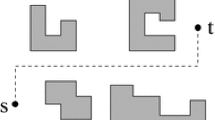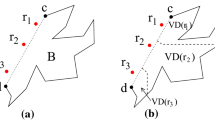Abstract
We present an optimal algorithm for determining a time-minimal rectilinear path among transient rectilinear obstacles. An obstacle is transient if it exists only for a specific time interval, i.e., it appears and then disappears at specific times. Given a point robot moving with bounded speed among non-intersecting transient rectilinear obstacles and a pair of points (s, d), we determine a time-minimal, obstacle-avoiding path from s to d. Our algorithm runs in \(\varTheta (n \log n)\) time, where n is the total number of vertices in the obstacle polygons. The main challenge in solving this problem arises when the robot may be required to wait for an obstacle to disappear, before it can continue moving towards its destination. Our algorithm builds on the continuous Dijkstra paradigm, which simulates propagating a wavefront from the source point. We also present an \(O(n^2 \log n)\) time algorithm for computing the Euclidean shortest path map among transient polygonal obstacles in the plane. This decreases the time complexity of the existing algorithm (Fujimura, in: Proceedings 1992 IEEE international conference on robotics and automation, vol 2, pp 1488–1493, 1992. https://doi.org/10.1109/ROBOT.1992.220041) by a factor of n. The shortest path map can be preprocessed for point location, after which a shortest path query from s to any point d can be answered in time \(O(\log n + k)\) where, k is the number of edges in the path.


















Similar content being viewed by others
Notes
Refer to Sect. 3.2 for a formal definition.
References
Agarwal PK, Arge L, Yi K (2005) An optimal dynamic interval stabbing-max data structure? In: Proceedings of the sixteenth annual ACM-SIAM symposium on discrete algorithms, SODA ’05. Society for Industrial and Applied Mathematics, Philadelphia, pp 803–812. http://dl.acm.org/citation.cfm?id=1070432.1070546
Agarwal PK, Kumar N, Sintos S, Suri S (2018) Computing shortest paths in the plane with removable obstacles. In: SWAT 2018, pp 5:1–5:15
Asano T, Asano T, Guibas L, Hershberger J, Imai H (1986) Visibility of disjoint polygons. Algorithmica 1(1):49–63. https://doi.org/10.1007/BF01840436
Berg Md, Cheong O, Mv Kreveld, Overmars M (2008) Computational geometry: algorithms and applications, 3rd edn. Springer, Santa Clara
Chazelle B (1988) Functional approach to data structures and its use in multidimensional searching. SIAM J Comput 17(3):427–462. https://doi.org/10.1137/0217026
de Rezende PJ, Lee DT, Wu YF (1985) Rectilinear shortest paths with rectangular barriers. In: SCG ’85. ACM, New York, pp 204–213. https://doi.org/10.1145/323233.323260
Edelsbrunner H, Guibas LJ, Stolfi J (1986) Optimal point location in a monotone subdivision. SIAM J Comput 15(2):317–340. https://doi.org/10.1137/0215023
Erdmann M, Lozano-Perez T (1986) On multiple moving objects. In: Proceedings of the 1986 IEEE international conference on robotics and automation, vol 3, pp 1419–1424. https://doi.org/10.1109/ROBOT.1986.1087401
Fujimura K (1992) On motion planning amidst transient obstacles. In: Proceedings 1992 IEEE international conference on robotics and automation, vol 2, pp 1488–1493. https://doi.org/10.1109/ROBOT.1992.220041
Fujimura K (1993) Motion planning using transient pixel representations. In: ICRA 1993, vol 2, pp 34–39. https://doi.org/10.1109/ROBOT.1993.292120
Fujimura K (1994) Motion planning amid transient obstacles. Int J Robot Res 13(5):395–407. https://doi.org/10.1177/027836499401300502
Ghosh SK, Mount DM (1987) An output sensitive algorithm for computing visibility graphs. In: 28th annual symposium on foundations of computer science (SFCS 1987), pp 11–19. https://doi.org/10.1109/SFCS.1987.6
Giora Y, Kaplan H (2009) Optimal dynamic vertical ray shooting in rectilinear planar subdivisions. ACM Trans Algorithms 5(3):28:1–28:51. https://doi.org/10.1145/1541885.1541889
Hershberger J, Suri S (1999) An optimal algorithm for euclidean shortest paths in the plane. SIAM J Comput 28(6):2215–2256. https://doi.org/10.1137/S0097539795289604
Hershberger J, Kumar N, Suri S (2017) Shortest paths in the plane with obstacle violations. In: ESA 2017, pp 49:1–49:14
Kirkpatrick D (1983) Optimal search in planar subdivisions. SIAM J Comput 12(1):28–35. https://doi.org/10.1137/0212002
LaValle SM (2006) Planning algorithms. Cambridge University Press, Cambridge
Lee D, Yang C, Wong C (1996) Rectilinear paths among rectilinear obstacles. Discrete Appl Math 70(3):185–215. https://doi.org/10.1016/0166-218X(96)80467-7
Mitchell JSB (1993) Shortest paths among obstacles in the plane. In: Proceedings of the ninth annual symposium on computational geometry, SCG ’93. ACM, New York, pp 308–317. https://doi.org/10.1145/160985.161156
Mitchell JS (1992) \(l_1\) shortest paths among polygonal obstacles in the plane. Algorithmica 8(1–6):55–88. https://doi.org/10.1007/BF01758836
Vaishnavi V, Wood D (1982) Rectilinear line segment intersection, layered segment trees, and dynamization. J Algorithms 3(2):160–176. https://doi.org/10.1016/0196-6774(82)90016-5
Wang H, Agarwal PK (1996) Approximation algorithms for curvature-constrained shortest paths. In: Proceedings of the seventh annual ACM-SIAM symposium on discrete algorithms, SODA ’96. Society for Industrial and Applied Mathematics, Philadelphia, pp 409–418. http://dl.acm.org/citation.cfm?id=313852.314093
Welzl E (1985) Constructing the visibility graph for n-line segments in \(o(n^2)\) time. Inf Process Lett 20(4):167–171. https://doi.org/10.1016/0020-0190(85)90044-4
Widmayer P, Wu Y, Wong C (1987) On some distance problems in fixed orientations. SIAM J Comput 16(4):728–746. https://doi.org/10.1137/0216049
Yang C, Lee D, Wong C (1995) Rectilinear path problems among rectilinear obstacles revisited. SIAM J Comput 24(3):457–472. https://doi.org/10.1137/S0097539792229672
Author information
Authors and Affiliations
Corresponding author
Additional information
Publisher's Note
Springer Nature remains neutral with regard to jurisdictional claims in published maps and institutional affiliations.
The preliminary version of this paper has appeared in Proceedings of the 12th Annual International Conference on Combinatorial Optimization and Applications (COCOA’18).
Rights and permissions
About this article
Cite this article
Maheshwari, A., Nouri, A. & Sack, JR. Shortest paths among transient obstacles. J Comb Optim 43, 1036–1074 (2022). https://doi.org/10.1007/s10878-020-00604-1
Published:
Issue Date:
DOI: https://doi.org/10.1007/s10878-020-00604-1




